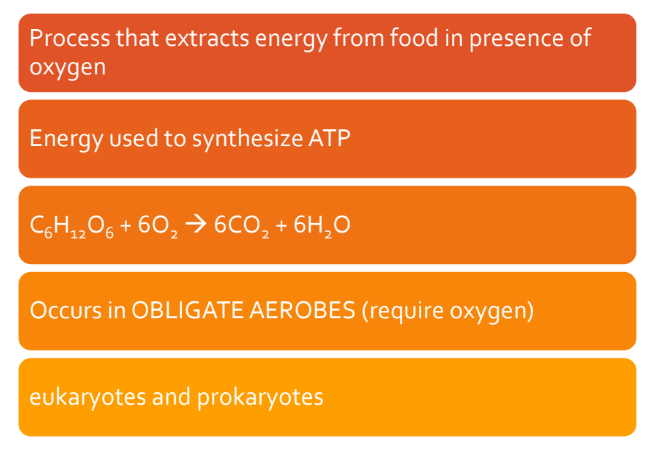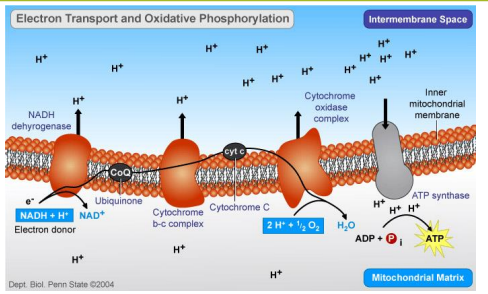4.1 Cellular Respiration: Introduction
Bond forming requires an input of energy

]]Sugar is high energy molecule]]
]]The high potential energy is extracted from these food molecules (O2 and Sugar)]]
]]That high potential energy is used to synthesize ATP]]
]]The chemical energy, which is now stored in ATP, can readily be released and used by the cell for most of the activities that require energy. ATP is the CASH MONEY of energy in the body.]]
}}The results of this process is H2O and CO2}}
}}With the help of sunlight & photosynthesis, these molecules turn into Sugar and O2}}
}}When O2 is unavailable, anaerobic cells have alternative ways to release energy from food molecules. (see bottom of note).}}
]]Aerobic Cellular Respiration:]] a process that uses oxygen to harvest energy from organic compounds

- Mitochondrion does this with its ATP production
- Glucose is broken down bit by bit rather than a big, combustion reaction like forest fires
- Obligate Aerobes: an organism that can not live without oxygen
- Most eukaryotes including plants and animals fall under here
- Much more efficient in eukaryotes
2 ways to produce ATP:
- Substrate Level Phosphorylation:
- ATP is formed directly by transfer of phosphate from substrate
- done by enzyme
- Enzyme forcing a phosphate from PEP over to ADP to make ATP

- Oxidative phosphorylation:
- ATP is formed indirectly through a redox reaction
- The energy of moving the phosphate came from oxidization (electron trasfer / redox)
- The energy that is released when the electron donor is oxidized is what helps the red proteins pump the H+
- Oxygen is the final electron acceptor

Stages of Cellular Respiration:
Glycolysis:
- In cytosol
- Glucose (or another fuel molecule) → 2 Pyruvate
- 1 6C Glucose →2 3C Pyruvate
- Some ATP made by SLP
Pyruvate Oxidation:
- In mitochondria
- Pyruvate are oxidized into → 6 CO2 (waste molecule), NADH and Acetyl-CoA (attached to coenzyme A)
Citric acid cycle/ Krebs Cycle:
- in mitochondria
- Acetyl-CoA oxidized to CO2, NADH, FADH2
- Carbon atoms are released as CO2 (waste)
- ATP made by SLP
- ATP (cash), NADH & FADH2 (cheques)
Electron transport chain
- In mitochondria
- Where the cheques are cashed in
- Oxygen is the BiggBoss
- NADH & FADH2 oxidized by series of oxidizing agent
- Ends with O2 reduced to H2O
- Their high-energy electrons and hydrogens are passed from one oxidizing agent to the next until they are transferred to O2, producing water.
- Large amounts of ATP are made by the free energy released from electron transport with OP

Mitochondrion:
Generates majority of ATP - powerhouse of the cell
Double membrane
Mitochondrion Matrix
- Pyruvate oxidation (1st)
- Citric acid cycle (2nd)
Inter-membrane space / Inner membrane
- Electron transport chain (3rd)

Prokaryotes:
- No mitochondrion so the process is difficult and inefficient
- Glcolysis can still be performed though in the cytosol
- electron transport occurs on internal membranes that are derived from the plasma membrane
- These prokaryotes possess the full complement of reactions that make up aerobic cellular respiration—from glycolysis through electron transport and oxidative phosphorylation.
Anaerobic Pathways:
- Generates ATP in the absence of oxygen
- Anaerobic Respiration:
- Similar to aerobic but final electron acceptor is not oxygen but other inorganic molecule
- Fermentation:
- No electron transport chain
- Uses organic molecule as oxidizing agent
- Both anaerobic respiration and fermentation are catabolic (energy-yielding) processes.
- C6H12O6 → 2 CH3CH2OH + CO2
- There is a striking difference between the small amount of free energy that is released by this fermentation pathway and the amount released during aerobic cellular respiration.
Anaerobic Organisms:
- Inobligate anaerobes
- Cannot survive in presence of oxygen
- Clostridium botulinum
- Many prokaryotes and some protists live in environments with little or no oxygen.
- bacteria that are responsible for tetanus and botulism poisoning, and the protist Trichonympha, which lives within the guts of termites and feeds on ingested cellulose
- lack mitochondrion and and reply on unusual fermentation pathway
- inorganic substances such as NO2, S, and Fe3+ as final electron acceptors to obtain energy.
- Facultative anaerobes
- Can survive with or without oxygen
- yeast and the E. coli bacteria that live in our gut
- Escherichia coli
Review:
- There are three main types of energy pathways: aerobic respiration, anaerobic respiration, and fermentation. They all produce ATP.
- The four stages of aerobic cellular respiration are glycolysis, pyruvate oxidation, the citric acid cycle, and the electron transport chain.
- Mitochondria generate most of the ATP that is used in eukaryotic cells
- Respiration pathways use electron transport systems to generate ATP by oxidative phosphorylation (but without the oxygen, inorganic instead). Fermentation pathways lack such transport systems (just use a different final acceptor, organic).
- Anaerobic respiration uses an inorganic substance other than oxygen as the final oxidizing agent. Fermentation relies on an organic compound.